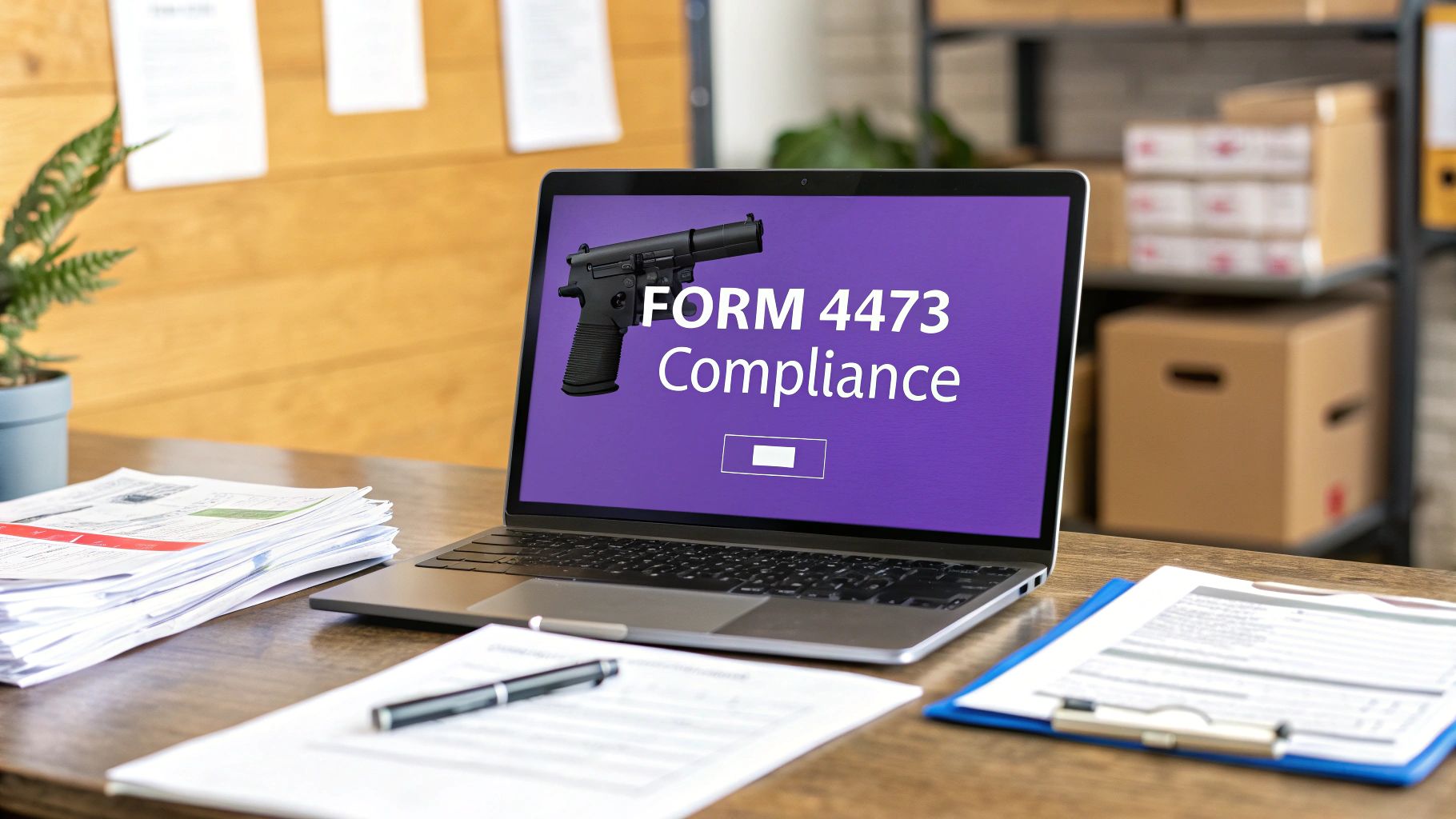
ATF Form 4473 and E-Commerce: What Online Firearm Retailers Need to Know
Learn everything about ATF Form 4473 and E-Commerce. Essential guide for online firearm retailers to stay compliant and streamline transactions.
Cody Y.
Updated on Sep 18, 2025
For any online firearms business, the ATF Form 4473 is the single most important piece of paper in the entire sales process. Think of it as the legally required handshake that connects your digital checkout to a compliant, in-person firearm transfer. It’s not just paperwork; it’s the bedrock of your e-commerce operation.
Why Form 4473 Is Your Most Critical E-Commerce Tool
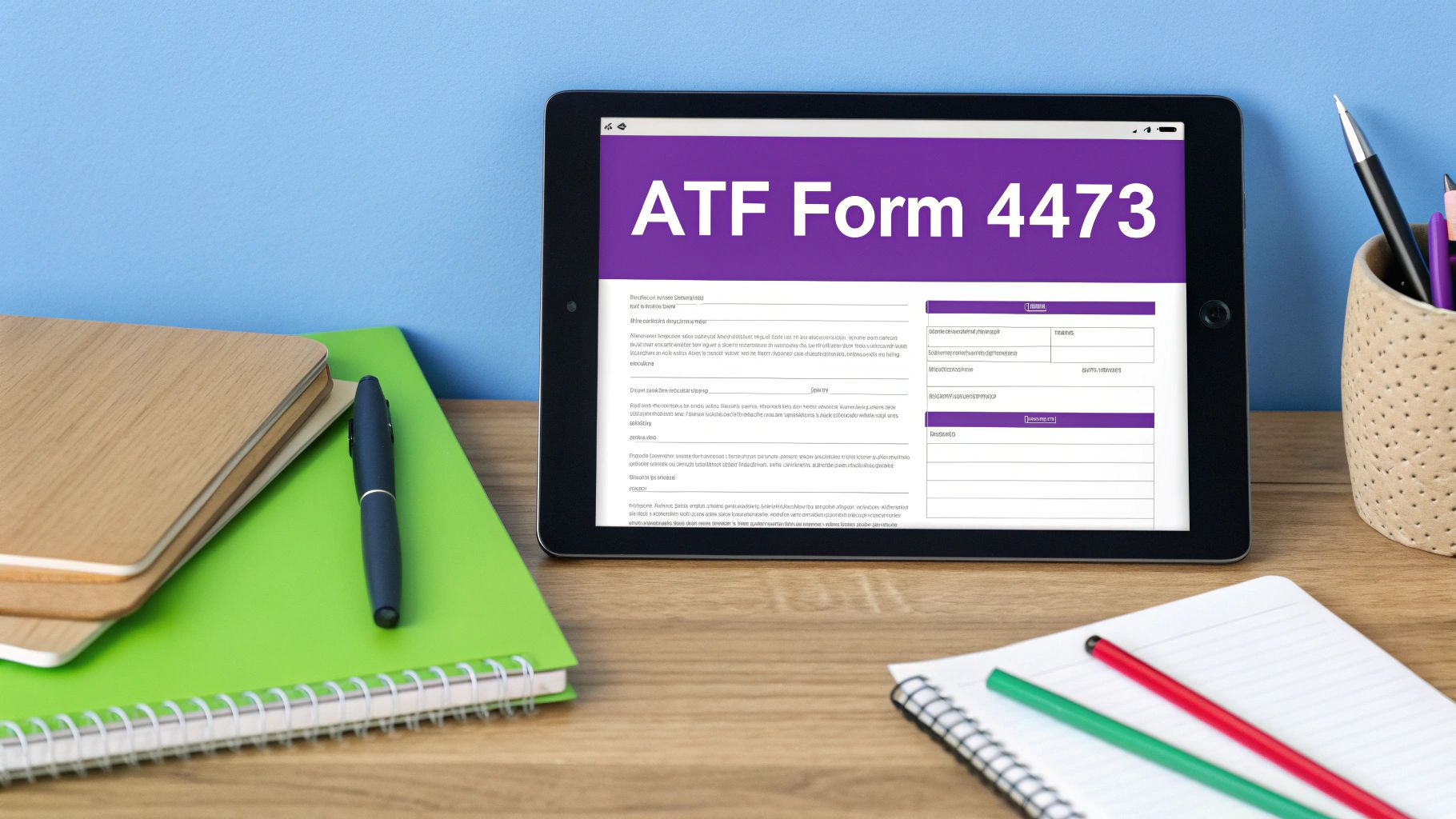
Selling firearms online has opened up a national market, but every single sale is funneled through one critical checkpoint: the ATF Form 4473. This form is far more than a bureaucratic formality—it’s the legal anchor that keeps your entire business afloat.
Your website essentially acts as a reservation system. A customer finds a firearm they want, adds it to their cart, and pays you online. But that's only step one. The transaction is nowhere near complete. That firearm can't just be boxed up and shipped to their front door. Instead, it must be sent to a local Federal Firearms Licensee (FFL) that the customer chooses.
The In-Person Connection
This is where the Form 4473 comes into play. Once the firearm arrives, the customer has to physically go to that local FFL, show their government-issued ID, and fill out the Form 4473 right there on the spot. The local dealer then uses the information on that form to run the mandatory National Instant Criminal Background Check System (NICS) check. Only after a "Proceed" comes back from the FBI can the firearm actually be handed over.
This two-step dance—online purchase followed by in-person verification and background check—is the core of every legal firearm e-commerce sale. Your job as the online retailer is to nail the first part of that process without a hitch.
This guide is all about connecting the dots between your e-commerce store and the mandatory in-person background check. We’ll break down how to manage the process, sidestep common compliance traps, and use smart tools to build a business that’s both scalable and legally sound.
Getting this workflow right isn't just about following the rules. It’s about building a trustworthy, sustainable business in a highly competitive market. Knowing your responsibilities protects your FFL and builds confidence with your customers. As the online seller, your key duties include:
- Verifying the receiving FFL's license is valid before you ship anything.
- Keeping flawless records of every firearm's disposition in your own A&D book.
- Building a clear line of communication with your network of transferring FFLs.
When you perfect this system, you turn a complex regulatory hurdle into a smooth, predictable, and legally bulletproof part of your business model.
How Online Sales And In-Person Transfers Actually Work
At first glance, selling a firearm online seems to fly in the face of the ATF’s strict, in-person requirements for Form 4473. How can you possibly run an e-commerce store when the law demands a physical, face-to-face transaction?
The answer is a mandatory two-step process that smartly separates the online purchase from the legal transfer.
Think of your online store less like a final point of sale and more like a high-tech reservation system. A customer finds a firearm they want on your website, adds it to their cart, and pays for it. This initial step is purely commercial—it secures the product for them, but it does not legally transfer ownership. The firearm is still yours.
The actual transfer doesn't begin until you, the seller, ship that firearm to another Federal Firearms Licensee (FFL) chosen by your customer. This is usually a local gun shop near their home. This second FFL, known as the "transferring FFL," acts as the final, legally-required gatekeeper for the entire sale.
The Critical Role Of The Transferring FFL
Once the firearm arrives at that local dealer, your customer has to physically go to their shop. This is where the digital world officially meets federal law. The customer must present their government-issued ID, and the transferring FFL hands them a fresh ATF Form 4473 to fill out right there on the spot.
This part is non-negotiable. The local dealer carefully reviews the completed form for any errors or red flags and then initiates the mandatory National Instant Criminal Background Check System (NICS) check. Only after getting a "Proceed" from NICS can the dealer legally hand the firearm over, finally completing the sale.
This infographic breaks down the core steps, from the buyer's initial verification to the final paperwork submission.
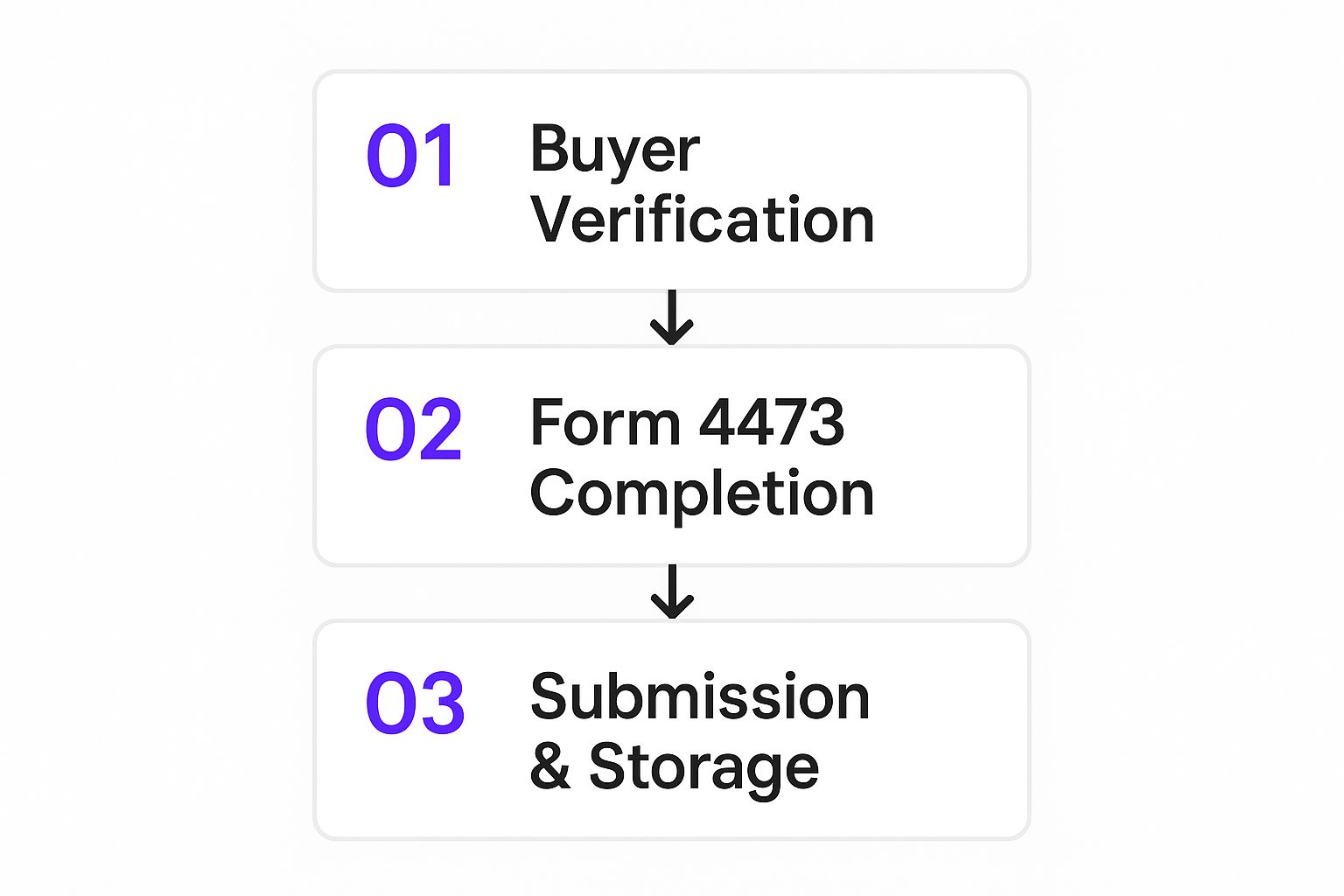
As you can see, the whole workflow is designed to move from a convenient online purchase to a mandatory, physical, and legally documented transfer.
This framework creates a clear and clean division of labor. Your job as the online retailer is to manage the initial sale, verify the receiving FFL’s license is active and valid, and get the firearm shipped out securely. Our guide on shipping firearms across state lines gets into the nitty-gritty of those logistics.
The transferring FFL, on the other hand, is legally responsible for everything that happens on their end: verifying the buyer's identity, overseeing the Form 4473 completion, running the background check, and keeping the final records.
To make the distinction crystal clear, here’s a side-by-side look at how a traditional in-store sale compares to an online one.
Online vs In-Person Firearm Sale Workflow
This table highlights the key differences and similarities, showing how the core compliance steps are preserved in an online model.
| Process Step | In-Person Sale (at FFL's Premises) | Online Sale (from Retailer's Website) |
|---|---|---|
| Product Selection | Customer browses and selects firearm in the store. | Customer browses and selects firearm on the e-commerce site. |
| Payment | Customer pays at the counter. | Customer pays online via credit card or other method. |
| Form 4473 Completion | Customer fills out Form 4473 in-store. | Customer fills out Form 4473 at their chosen local FFL. |
| Identity Verification | Selling FFL verifies customer's ID in person. | Transferring FFL verifies customer's ID in person. |
| NICS Background Check | Selling FFL initiates the NICS check. | Transferring FFL initiates the NICS check. |
| Firearm Transfer | FFL hands firearm to customer upon NICS "Proceed." | Transferring FFL hands firearm to customer upon NICS "Proceed." |
As you can see, the critical compliance tasks simply shift from the seller to the local transferring FFL, ensuring every legal box is checked.
Understanding Your Legal Obligations
Federal law has caught up to e-commerce by cementing this two-step process. ATF Form 4473 was born from over-the-counter sales, but modern regulations like 18 U.S.C. § 922(c) and ATF Procedure 2020-1 now explicitly allow online sales—as long as the firearm is shipped to another FFL for the final, in-person transaction.
This system cleverly keeps the essential safeguards of the background check system fully intact while allowing you to reach a national customer base.
Key Takeaway: Your online store facilitates the purchase, but the local FFL facilitates the legal transfer. Getting this distinction right is the bedrock of compliance. Every single online sale must end with an in-person, documented transfer managed by a licensed dealer.
Mastering this workflow isn't just about following the rules; it's the key to building a successful, scalable, and legally sound online firearms business.
Avoiding Common and Costly Form 4473 Violations
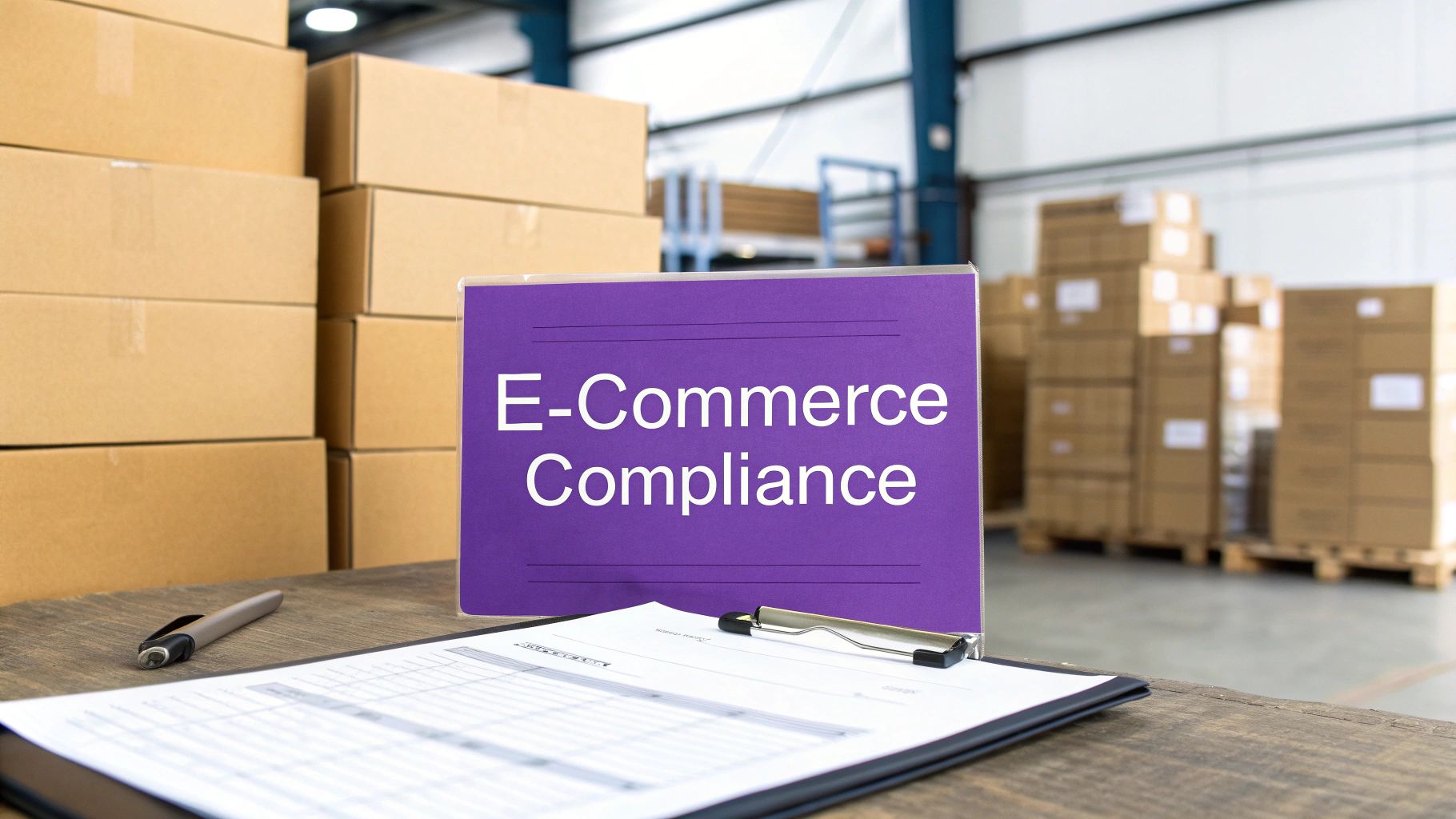
For an online firearms business, perfect compliance isn't just a goal—it's the only way to stay in business. Even though you don’t handle the final, in-person transaction, the integrity of your FFL network and your own records are always under a microscope. One simple mistake on an ATF Form 4473, even if it’s made by a partner FFL, can create serious problems that trace directly back to you.
The ATF doesn’t mess around with record-keeping. What might look like a minor clerical error during an inspection can quickly escalate into warning letters, hefty fines, license revocation, or even criminal charges. This isn't about fear; it's about understanding the stakes and building a rock-solid operational discipline that squeezes out the risk.
The Most Frequent ATF Inspection Violations
If you look at ATF inspection data, you’ll see the same mistakes pop up again and again. These aren’t obscure technicalities—they're fundamental errors in the transaction process. By knowing what inspectors look for first, you can strengthen your own procedures and do a better job of vetting your FFL transfer partners.
The top violations that get cited time after time include:
- Failure to Properly Complete Form 4473: This is the big one. It covers everything from missing signatures and dates to incomplete buyer information.
- Incorrectly Recording Buyer Identification: An inspector will immediately flag any failure to accurately record the details from a government-issued photo ID.
- Improper Documentation of NICS Background Check: Mistakes in recording the NICS transaction number (NTN) or the final response—"Proceed," "Denied," or "Delayed"—can invalidate the entire sale.
- Failure to Record Firearm Information Accurately: Transposing serial numbers or incorrectly listing the firearm's model, type, or manufacturer is another all-too-common and costly slip-up.
These errors highlight why a meticulous, double-check-everything process is critical at the point of transfer. As an online seller, your choice of FFL partners is your first line of defense.
The Real-World Impact of Non-Compliance
The consequences for getting this wrong are very real. The ATF's enforcement actions show a clear and present danger for FFLs who fail to keep perfect records, especially with Form 4473.
The ATF's oversight of Form 4473 compliance reveals ongoing challenges, with errors in completion being a significant source of regulatory enforcement actions. In fiscal year 2024, the ATF conducted 9,696 firearm compliance inspections, uncovering over 32,000 violations specifically related to incorrect or incomplete handling of ATF Form 4473.
These numbers are a stark reminder of the regulatory environment we operate in. In 2024 alone, these inspections led to 7,432 firearms-related cases being referred for prosecution, which resulted in over 4,700 indictments and more than 4,000 convictions. For online retailers, whose business model adds another layer of complexity, meticulous adherence is the only path forward. You can dig into more details on these findings and learn about the most common ATF Form 4473 errors and their consequences on orchidadvisors.com.
Building Your Defense Through Process and Partnerships
While the transferring FFL is on the front line filling out the form, your business is far from immune. The best way to protect your own license is to build a robust internal process and be extremely selective about your FFL transfer partners.
Before adding an FFL to your network, ask them about their compliance procedures. Do they use a two-person check system to review every Form 4473 before it’s filed? Are they using modern electronic record-keeping systems to cut down on data entry errors? A partner who obsesses over compliance is one of the most valuable assets you can have, shielding your online operation from downstream risk.
Building a Compliant E-Commerce and FFL Transfer Workflow
Running a successful online gun store is all about the workflow. From the customer's perspective, it’s just a simple click-and-buy experience. But on your end, it has to be a rock-solid, disciplined process that ensures total compliance from the second that order hits your system. This isn't just a "best practice"—it's your first and best defense against violations that could cost you your business.
Think of it like a legal assembly line. Every single station has to do its job perfectly before the transaction can move to the next stage. If even one step is missed, the whole line grinds to a halt, putting your Federal Firearms License (FFL) in jeopardy.
Stage 1: The Customer Order and Initial FFL Vetting
The process kicks off the moment a customer clicks "confirm purchase." Your first move isn't packing the box. It’s managing the FFL transfer. Your customer has to choose a local FFL dealer who will receive the firearm and handle the in-person background check and paperwork.
As soon as they give you that dealer’s information, your compliance clock is officially ticking. You are now responsible for verifying that the receiving FFL's license is valid and in good standing.
- Use the ATF's FFL EZ Check System: This is non-negotiable. It's a free online tool from the ATF. You plug in the dealer's license number and instantly confirm its validity.
- Request a Signed Copy of the FFL: Before you ship anything, get a signed, clear copy of the receiving dealer's license for your records. This creates a paper trail proving you did your due diligence.
- Maintain an FFL Database: It pays to keep a running list of FFLs you've worked with and trust. This not only speeds up future orders but helps you build a network of dealers you know are reliable and easy to work with.
Skipping this verification is one of the fastest ways to get hit with a serious ATF violation. You are 100% legally on the hook for making sure you only ship firearms to valid license holders.
Stage 2: Documentation and Secure Shipment
Once you've confirmed the receiving FFL is good to go, the next phase is all about meticulous records and secure logistics. This is where your internal checklists become your best friend. Before any firearm leaves your shop, it must be properly logged out of your Acquisition and Disposition (A&D) book.
Key Takeaway: Your A&D book is the legal diary of your business. Every firearm that comes in and goes out must be recorded. An incomplete or inaccurate entry for a shipped gun is a direct violation and one of the first things an ATF inspector will look for. Every detail has to be perfect.
The disposition entry in your A&D book needs to include the firearm’s details, the date it was shipped, and the name and license number of the FFL it was sent to. This record is your proof of a compliant transfer on your side of the transaction. For a detailed guide on setting this up in your store, our article on FFL dealer shipping restrictions for WooCommerce is an essential read for anyone on that platform.
Stage 3: Communication and Finalizing the Transfer
After you’ve shipped the firearm, your job still isn't quite finished. Good, clear communication with both your customer and the transferring FFL is the last piece of the puzzle for a smooth experience.
- Notify the Customer: Send them a shipping confirmation with the tracking information so they know it's on the way.
- Inform the Receiving FFL: Give the FFL a heads-up with the tracking number and an estimated arrival date. This lets them prepare to receive and log it into their own A&D book promptly.
- Follow Up: While the receiving FFL handles the final Form 4473 and the NICS check, maintaining a good relationship with them makes the whole process better for your customer.
This entire workflow—from the initial order all the way to the final transfer—is about building a defensible business process. If you want to dive deeper into the legal framework for building a sound online store, it’s worth looking into resources that offer legal expertise in e-commerce solutions. By locking down your verification, documentation, and communication, you turn a mountain of complex legal requirements into a repeatable, efficient, and safe part of your daily operations.
Automating Shipping Compliance in Your Online Checkout
<iframe width="100%" style="aspect-ratio: 16 / 9;" src="https://www.youtube.com/embed/WjE0tyUHwzo" frameborder="0" allow="autoplay; encrypted-media" allowfullscreen></iframe>For any online firearms retailer, the dizzying patchwork of state, county, and city-level gun laws is one of the biggest operational headaches. An accessory that’s perfectly legal to sell in one state might be completely banned just a few miles away in a neighboring town.
Trying to keep up with this constantly shifting legal map by hand isn't just difficult—it’s a recipe for compliance failures. It turns your team into reluctant legal experts on hundreds of jurisdictions, a job that’s both inefficient and incredibly risky. A single mistake, like shipping a restricted magazine to the wrong zip code, can lead to canceled orders, angry customers, and serious legal heat for your FFL.
The Modern Fix for a Complex Problem
Instead of wrestling with spreadsheets and manual checks, smart e-commerce retailers now lean on automated shipping restriction software. Think of it as a digital compliance officer built right into your store’s checkout. It works around the clock in the background, making sure every single order is legally sound before it even hits your queue.
Tools like Ship Restrict plug directly into e-commerce platforms like WooCommerce. They act as an intelligent gatekeeper, instantly cross-referencing two critical pieces of information:
- The customer’s shipping address: The software checks the state, county, city, and even ZIP code against a massive, continuously updated legal database.
- The products in their cart: It identifies specific items, whether it's certain types of rifles, high-capacity magazines, or other regulated accessories.
If the system flags a product in the cart as prohibited at the customer's location, it automatically blocks the sale from going through. This proactive block stops illegal sales before they ever become a problem, protecting your business from liability.
This screenshot gives you a peek at how a shipping restriction tool looks on the back end—a clear interface for setting up rules without needing a law degree.
The real magic here is turning a huge legal challenge into a manageable task you can handle from a simple dashboard.
Key Benefits of Automated Compliance
Bringing in an automated solution does a lot more than just stop bad shipments. It sharpens your entire operation, delivering real-world benefits that strengthen your business from the ground up.
- Slashed Compliance Risk: This is the big one. Automation all but eliminates the human error that leads to shipping violations, safeguarding your FFL from hefty fines or even revocation.
- Fewer Canceled Orders: By catching restricted sales at checkout, you skip the frustrating and costly process of canceling an order after it’s already been paid for and processed.
- A Better Customer Experience: Instead of a surprise cancellation email days later, customers get an immediate, clear message explaining why an item can’t ship to them. This transparency builds trust and cuts down on confused support tickets.
- Streamlined Operations: Your team can finally stop spending hours each week cross-checking addresses against complex legal charts. This frees them up to focus on what actually grows the business: great customer service and smart marketing. For those on WordPress, our guide to automated shipping compliance for WooCommerce stores breaks down the entire implementation process.
The Takeaway: Manual compliance is reactive and risky. Automated compliance is proactive and protective. It transforms a heavy legal burden into a smooth, seamless part of your e-commerce workflow, ensuring every sale is a safe sale.
For FFLs with very specific compliance needs, it’s worth exploring how customizable AI solutions for unique business requirements can be adapted to your workflow. By embracing this kind of technology, you're not just buying software; you're investing in a more secure, efficient, and scalable future for your business.
Understanding the Online Firearm Sales Market
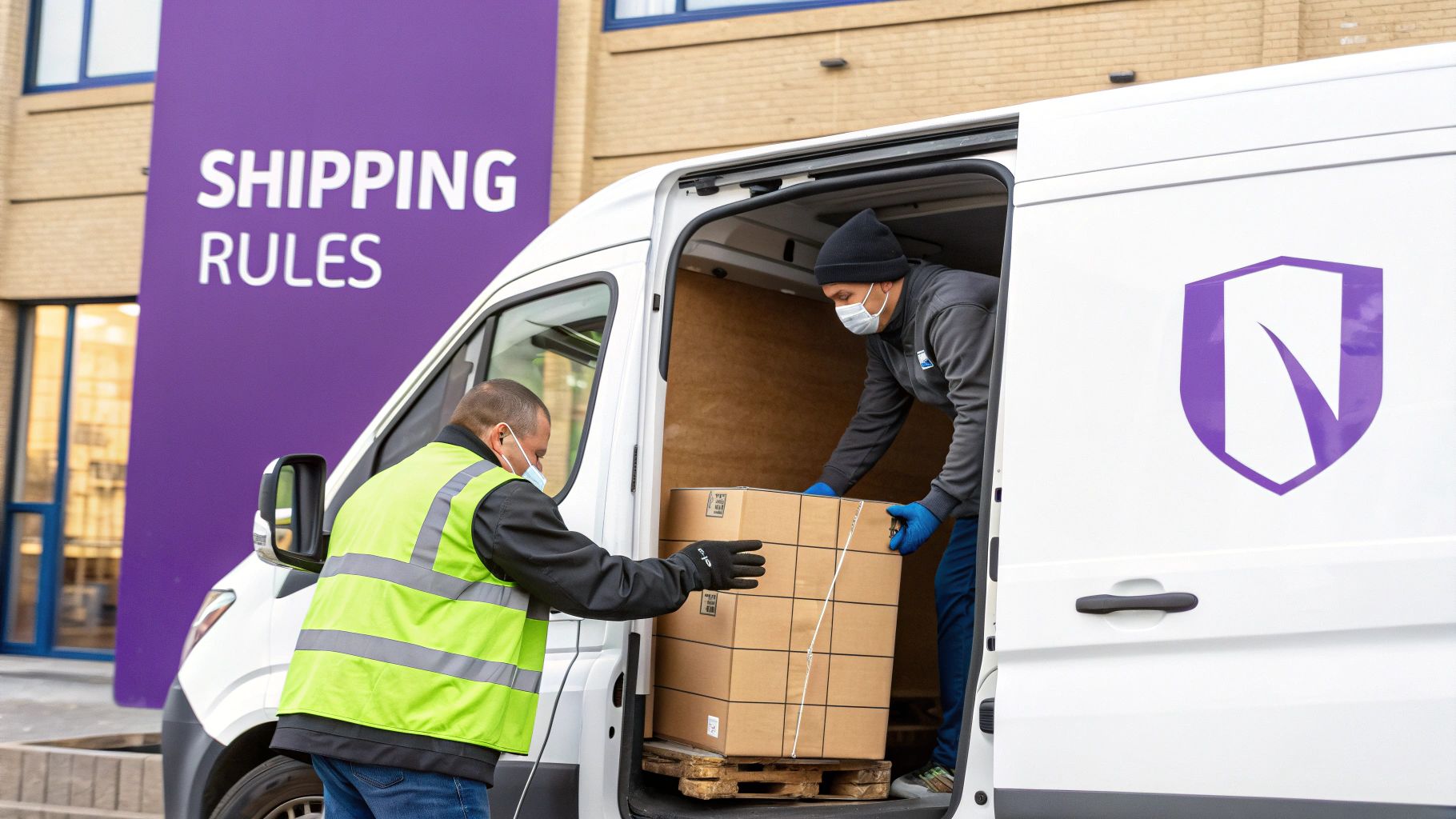
If you’re serious about selling firearms online, you first need a solid grasp of the landscape. The biggest trend shaping this business isn't just about what you sell, but how you sell it. We're seeing a steady migration of customers from local gun shops to online storefronts, and that shift changes everything.
While the total number of guns sold might dip up or down in any given year, the move to digital is a powerful, one-way street. This puts incredible pressure on your operations. In a crowded online space, the retailers who thrive aren't just the ones with the best inventory—they’re the ones with the most buttoned-up, compliant, and seamless processes.
Navigating Market Dynamics
For an online FFL, this reality transforms a couple of basic legal duties into your most powerful competitive advantages.
- Flawless Form 4473 Compliance: Every single online sale has to end with a perfect, in-person transfer. This makes your network of FFL partners and your own record-keeping absolutely critical to your survival.
- Automated Shipping Logistics: Trying to manually track the tangled web of state, county, and local shipping restrictions is a recipe for disaster. Automation isn't a luxury anymore; it's the only way to scale your business without drowning in spreadsheets.
Think of these two pillars as the foundation of any modern, resilient online firearm business. Get them right, and you're built to last.
The total number of U.S. firearm sales has cooled off since the peaks around 2020. In 2024, an estimated 16.17 million firearms were sold, which is a 3% decrease from 2023. Even so, this represents nearly 7% of all American adults buying a firearm.
This data tells a crucial story. Even in a slightly tighter market, the e-commerce slice of the pie is huge, which only intensifies the need for perfect ATF Form 4473 compliance. A dip in overall sales doesn't mean less regulatory heat—in fact, it makes every lawful transaction you complete that much more important. For more details on this data, you can check out these firearms sales statistics on safehome.org. Mastering compliance isn't just about following the rules; it's how you protect and grow your share of the market.
Common Questions About E-Commerce and Form 4473
Selling firearms online means juggling federal paperwork with the speed of e-commerce. It's a place where a lot of questions pop up, and getting clear, direct answers is the only way to run a confident and compliant business. Let's walk through some of the most common hurdles online FFLs face every day.
Think of each of these questions as a critical checkpoint in your online sales process. Nailing down these details helps you build an operational flow that's not just efficient, but legally sound.
Can My Customer Fill Out Form 4473 Online?
This is easily one of the most frequent—and most important—questions we hear. The short answer is no, not completely. While the ATF does offer an electronic version, the e-Form 4473, the final, legally binding steps absolutely must happen in person.
A customer can fill out their portion of the form on a computer at home to speed things up at the counter. But that's where the "online" part ends. They must physically show up at the transferring FFL's licensed premises to review, sign, and date the form right there in front of the dealer. There is simply no remote or fully digital shortcut for this final, crucial step.
Who Is Responsible for Errors on the Form?
This is a classic "shared responsibility" situation, but the weight isn't distributed evenly. The transferring FFL—the one physically overseeing the transaction—holds the primary responsibility for making sure the Form 4473 is perfect and the NICS check is done correctly. The buck stops with them because they're the ones managing the paperwork face-to-face.
But as the online seller, you aren't completely off the hook. Far from it. Your legal duty is to keep a flawless disposition record of that firearm in your A&D book and to prove you shipped it to a legitimate, licensed FFL. This is exactly why choosing reputable, meticulous FFL partners is one of the most critical business decisions you'll ever make.
How Do Shipping Restriction Tools Handle Different Products?
This is where good automation becomes a game-changer. Sophisticated tools maintain a massive, constantly updated database that knows the difference between all the products you sell. They can instantly distinguish between:
- Highly regulated firearms that have to follow strict FFL transfer rules.
- Restricted accessories, like high-capacity magazines, which are governed by their own tangled web of state and local laws.
- Non-regulated items like t-shirts, optics, or cleaning kits that can ship directly to a customer's door, no questions asked.
A smart system cross-references the specific item in the cart, the customer's full shipping address, and the most current laws for that exact jurisdiction. It then applies the correct shipping rules automatically, only blocking the sales that are genuinely prohibited.
What Records Must I Keep as the Online Seller?
While the transferring FFL down the road is keeping the physical, completed Form 4473, your own records are just as vital for staying compliant. As the original seller who shipped the firearm, you are required to maintain a perfect disposition record in your own Acquisition and Disposition (A&D) book.
This single entry is your legal proof of a compliant transfer. It has to include the firearm's complete details (manufacturer, model, serial number), the date you shipped it, and the full name and license number of the FFL you sent it to. When the ATF comes for an inspection, your A&D book will get just as much scrutiny as any stack of 4473s.
Automating your shipping compliance is the single best step you can take to protect your FFL and make your operations smoother. With a tool like Ship Restrict, you can finally eliminate the guesswork and human error that comes with trying to track thousands of local laws. Stop losing sleep over costly shipping mistakes and start focusing on growing your business.
Learn how Ship Restrict can safeguard your e-commerce store today.

Cody Yurk
Founder and Lead Developer of ShipRestrict, helping e-commerce businesses navigate complex shipping regulations for regulated products. Ecommerce store owner turned developer.